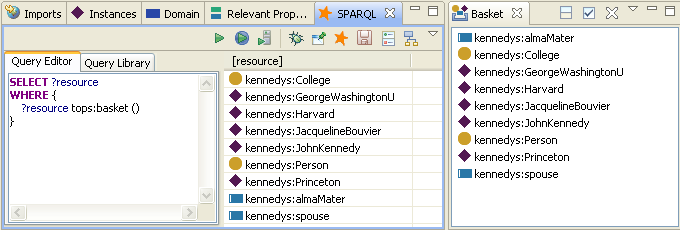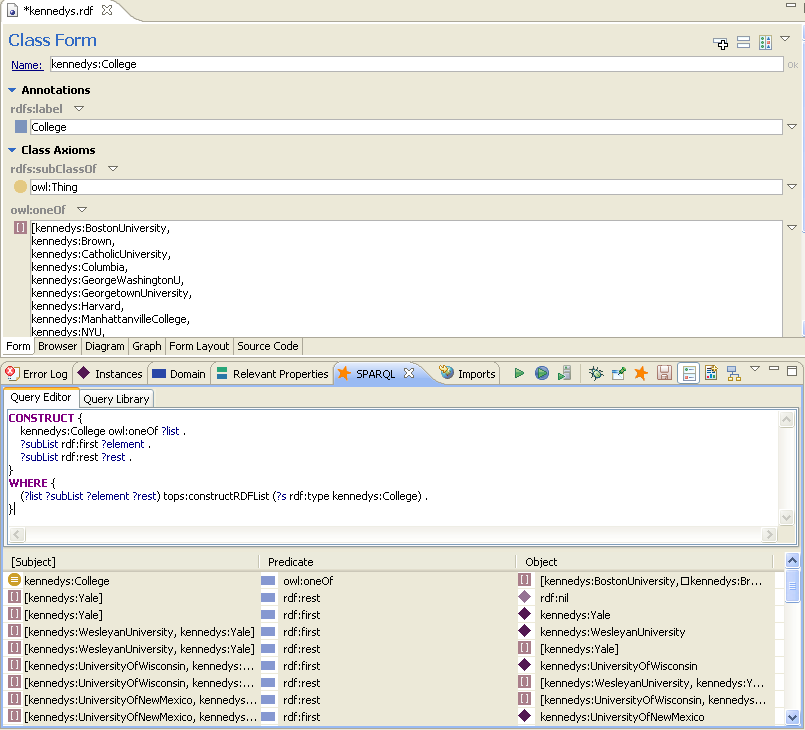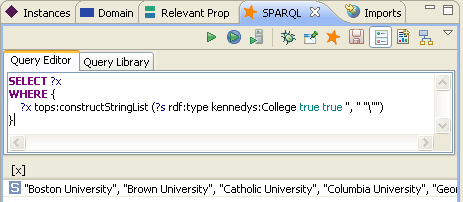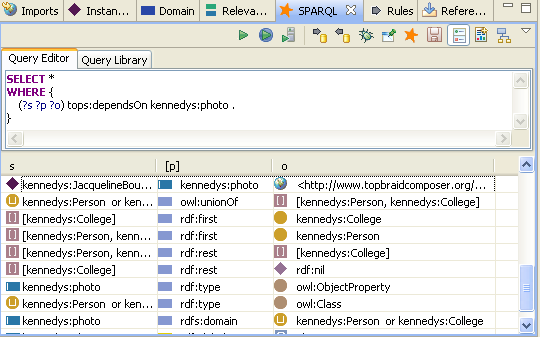SPARQL Property Functions
Property
functions in SPARQL are properties that return results based on executing code
rather than directly graph matching. Property functions, also referred to as "magic properties",
differ from SPARQLMotion Functions in that multiple bindings can be returned.
TopBraid Composer provides its own property functions to extend the functionality
of SPARQL. The following sections describe property functions available in TopBraid Suite:
- tops functions: These are available for all TBS platforms
and use the tops prefix, which stands for the
namespace http://www.topbraid.org/tops#
- TopBraid Live functions: These functions are available for TopBraid Live only.
Note that in addition to these property functions, SPARQL also provides BIND/FILTER
functions. TopBraid Composer supports all functions implemented by Jena, plus several
additional ones. These are described in the SPARQLMotion
Functions Reference.
If you want to add your own property functions, you can use SPIN's support for
magic properties to declare
new functions without programming. If you are a Java programmer, you can also add
your new property functions using the Jena API and TopBraid extension points.
tops Functions
The following functions are available for all TBS platforms.
-
tops:basket
This property function returns all resources in any basket.
- Syntax: ?resource tops:basket ()
- Description: The function assigns all resources from any basket to
?resource variable.
- Example: In the following query, tops:basket returns all the
resources that have been dragged into the basket to the right of the SPARQL view.

-
tops:constructRDFList
(Experimental) This function binds variables for constructing an RDF list.
It can be best used in a CONSTRUCT query. It is an experimental function, so it may work
only in certain cases.
- Syntax: (?list ?subList ?element ?rest) tops:constructRDFList (?s ?p ?o) .
- Description: The function iterates through ?s ?p ?o to
bind variables for constructing a list. Currently, only one variable in ?s ?p ?o
should be unassigned, and the other two should be assigned. Also the property "rdf:type" should be used instead of "a".
?list variable is used as the head
of the list and stays constant throughout the iteration, ?subList
is used as the sub heads of the list and changes with each iteration, ?element
is the unbound variable in ?s ?p ?o and changes with each iteration,
and ?rest is the bound ?subList of the
next iteration, which the current iteration points to.
- Example: In the following query, tops:constructRDFList constructs
an owl:oneOf list of colleges. Here is the query and its usage in kennedys ontology:
CONSTRUCT {
kennedys:College owl:oneOf ?list .
?subList rdf:first ?element .
?subList rdf:rest ?rest .
}
WHERE {
(?list ?subList ?element ?rest) tops:constructRDFList (?s rdf:type kennedys:College) .
}

Known limitations: Only one variable in ?s ?p ?o
should be unassigned, and the other two should be assigned. The property "rdf:type" should be used instead of "a" in the function.
tops:constructStringList
This function binds variables for constructing a string list.
- Syntax: ?x tops:constructStringList (?s ?p ?o ?useLabel ?doSort ?separator ?wrapper)
- Description: The function iterates through ?s ?p ?o to
construct a string from the binding of the unassigned variable.
?useLabel is an optional
boolean variable, which uses the rdfs:label value of the unassigned variable,
if it is a resource. ?doSort is an optional boolean variable for
sorting the list. ?separator is an optional string used as a separator between
members of the list.?wrapper is an optional string
which occurs at the beginning and end of each member of the list.
- Example: In the following query, tops:constructStringList constructs
a string list of colleges. The resulting list consists of the labels of the
colleges, sorted, separated by a comma and whitespace and wrapped by quotes.
Here is the query and its usage in kennedys ontology:
SELECT ?x
WHERE {
?x tops:constructStringList (?s rdf:type kennedys:College true true ", " "\"")
}

Known limitations: Only one variable in ?s ?p ?o
should be unassigned, and the other two should be assigned. The property "rdf:type" should be used instead of "a" in the function.
tops:definesStatements
- Syntax: ?baseURI tops:definesStatements (?subject ?predicate ?object)
- Description: Returns the statements at the variables ?subject ?predicate ?object defined in the ontology having a base URI, which is represented by the optional, bound or unbound variable ?baseURI.
If ?baseURI is bound, then the statements in the corresponding ontology are returned.
If ?baseURI is an unbound variable, then the base URI of the currently selected ontology is returned at ?baseURI as well as the statements in the corresponding ontology. (In SPARQLMotion, this case might behave differently)
If ?baseURI is not given, i.e. blank subject, then the statements in the current graph are returned.
- Example 1: If ?baseURI variable is bound as a uri node:
SELECT ?subject ?predicate ?object
WHERE {
<http://topbraid.org/sparqlmotion> tops:definesStatements (?subject ?predicate ?object)
}
The above query returns all statements defined in the ontology with the base URI http://topbraid.org/sparqlmotion.
- Example 2: If ?baseURI is a variable:
SELECT ?baseURI ?subject ?predicate ?object
WHERE {
?baseURI tops:definesStatements (?subject ?predicate ?object)
}
The above query returns all statements defined in the currently selected ontology. The base URI of the ontology is also returned.
- Example 3: If ?baseURI is not given:
SELECT ?subject ?predicate ?object
WHERE {
() tops:definesStatements (?subject ?predicate ?object)
}
The above query returns all statements defined in the current graph.
tops:dependsOn
This function returns statements depending on the input resource. The dependency
in this context means that the returned statements can only exist with the
input resource. The input resource can be a URI resource or blank node.
- Syntax: (?s ?p ?o) tops:dependsOn ?x
- Description: The function generates ?s ?p ?o, which depends on the
URI resource or blank node ?x.
- Example: In the following query, tops:dependsOn constructs
the statements that depend on kennedys:photo.
The results mostly contain the statements using kennedys:photo as a property.
However, there is also rdfs:domain on this property, which has a
owl:unionOf list. In addition to the head of the list, all statements inside
it also depend on kennedys:photo.
SELECT *
WHERE {
(?s ?p ?o) tops:dependsOn kennedys:photo .
}

Known limitation: This function should be used with more care in
SPARQLMotion, as the SPARQLMotion script may not have included obvious
default inferences like ?c rdfs:subClassOf owl:Thing,
if ?c is not a subclass of any class. The user may need to add more
SPARQLMotion modules to handle such corner cases before running this function.
tops:files
This function can be used to traverse the files in the workspace.
A typical use case of this is in conjunction with SPARQLMotion scripts to do
batch processing of multiple files, where the exact names of the files are unknown.
tops:for
This property can be used to implement loops over a range of integer values.
- Syntax: ?index tops:for ( [startIndex] [endIndex] )
- Description: The function iterates over all xsd:integer values >= startIndex
and <= endIndex and assigns all those values to the variable on the left side
- Example: In the following query, the variable index
will be bound to the xsd:integer values 2, 3, and 4.
?index tops:for (2 4)
tops:foreach
This function binds the input arguments on the right to the variables on the left.
- Syntax: ?x tops:foreach (?arg1 ?arg2 ?arg3...)
- Description: The function binds an iteration of ?x
variable bound from the input arguments.
- Example: In the following query, tops:foreach returns
kennedys:College,
kennedys:Gender,
kennedys:Person and
kennedys:Profession in the result set.
SELECT *
WHERE {
?x tops:foreach (kennedys:Gender kennedys:College kennedys:Person kennedys:Profession)
}
tops:localRanges
Iterates through all defined ranges for a given class/property pair, including
handling of owl:unionOf ranges.
- Syntax: (?cls ?property) tops:localRanges ?range
- Description: ?cls and ?property must be bound and ?range must be unbound.
Will bind ?range to all range resources, either using owl:allValuesFrom restrictions
or global rdfs:ranges
tops:relevantPropertiesOfClass
Gets a list of all properties that are "relevant" for a given class.
This includes all properties with matching domains and the restricted properties.
- Syntax: ?property tops:relevantPropertiesOfClass ?class
tops:relevantPropertiesOfInstance
Gets a list of all properties that are "relevant" for a given subject
resource. This includes all properties that already have a value for
the subject plus those with matching domains and the restricted properties.
- Syntax: ?property tops:relevantPropertiesOfInstance ?resource
tops:restrictedProperties
Gets a list of all properties that are mentioned in some restriction relevant to a given class.
- Syntax: ?property tops:restrictedProperties ?cls
tops:split
This function can be used to split a string into multiple sub-strings
separated by a given regular expression.
tops:statementDefinedIn
tops:transitiveAssociation
Gets subjects that are connected to an object via a transitive property.
For instance, find all resources that are directly or indirectly
rdfs:subClassOf a given class. Both the subject and object
must be bound when the function is called. This function has the advantage of having
the transitive property as a variable, when compared to property paths.
- Syntax: ?subject tops:transitiveAssociation (?property ?object)
- Example: Example to get all classes that are subClassOf
owl:Thing (including owl:Thing):
SELECT *
WHERE {
?cls tops:transitiveAssociation (rdfs:subClassOf owl:Thing) .
}
TopBraid Live Functions
The following functions are available for TopBraid Live only.



